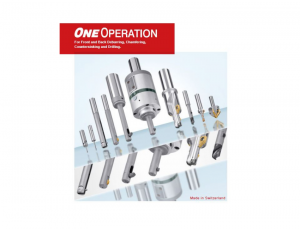COFA
In Process Deburring with COFA – Front and back deburring of even and uneven bores in one single pass
• No need to rotate the workpiece or stop the spindle
• Radius-formed deburring profile
• Standard range starting from bore diameter 2.0 mm
• Cassette solutions from bore diameter 10.0 mm
The range includes deburring tools for use on bore diameters from 2.0 mm to 26.0 mm. Any size bore diameter can be deburred using cassettes. The deburr size ranges from 0.1 mm to a maximum of 1.4 mm radially, depending on bore dimension and blade selection. The blades are available for both forward and backward cutting, as well as backward cutting only. The COFA operates reliably in both CNC and manual operations. The COFA is used for deburring bores in metal or other materials.
The design principle of the COFA deburring tools has proven itself over decades. Due to the dimensions, there are two different construction methods. On the COFA C2/C3 and 4M/5M, the blade and blade holder are a single unit. However, on the COFA C6 to C12, the blade and blade holder have been separated to provide a more solid guide for the blade holder.
The COFA works with replaceable carbide blades, which are coated depending on the workpiece material. The blade’s unique geometry is responsible for the consistent deburring result. Different blade lengths on the COFA C6 to C12 allow for the production of different deburring diameters using the same deburring tool.
In Process deburring with COFA is very straightforward. The burr on the front bore edge of the workpiece is removed during forward working feed at working speed. The blade then pivots into the tool body as it enters the bore. The result is a bore edge that has a radius profile and is uniformly deburred.
The tool then moves through the bore in rapid feed without stopping the spindle. The process does not damage the bore’s interior surface. In backwards working feed, the back edge of the bore is then deburred. Once the back deburring is complete, the tool can be removed from the bore in rapid feed.
The blade, which can rotate in the tool body, is spring-loaded. As a result, the cutting edge also follows uneven bore edges. This is required, for example, when deburring bores in a pipe. The deburring result is always the same, even if the height of the machining plane changes due to tolerances (e.g. cast parts).

More information for In Process Deburring with COFA at – https://www.heule.com/en
Privacy Policy |
Sitemap
Copyright 2024 DC Swiss UK
Website Hosted by RyderTech Ltd